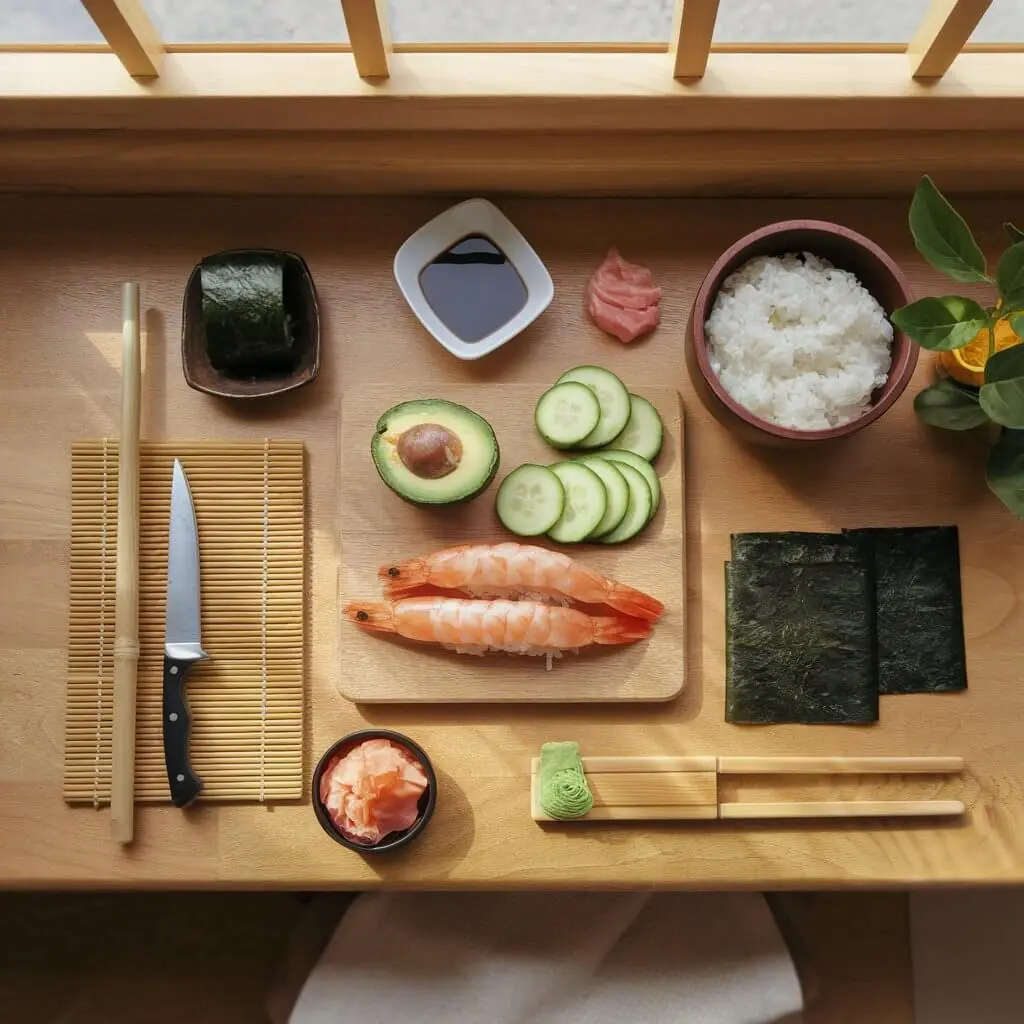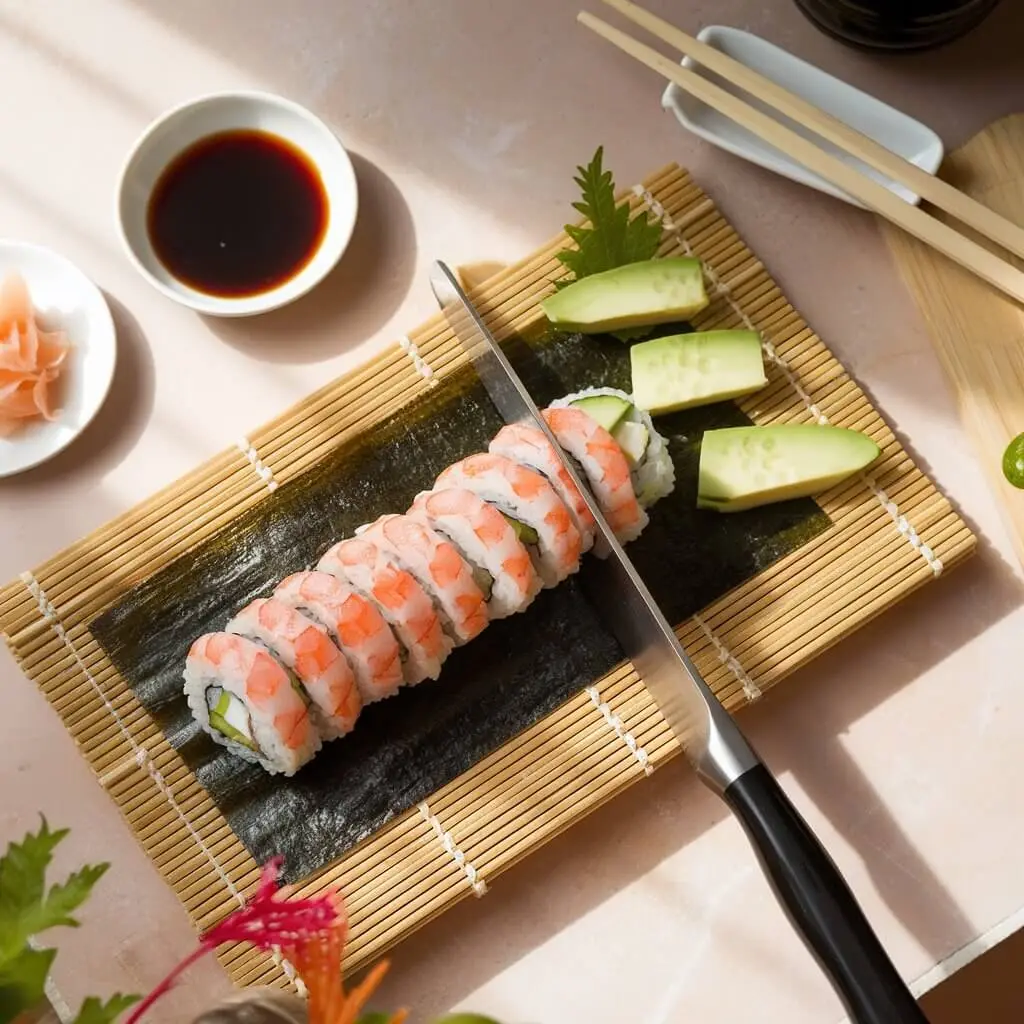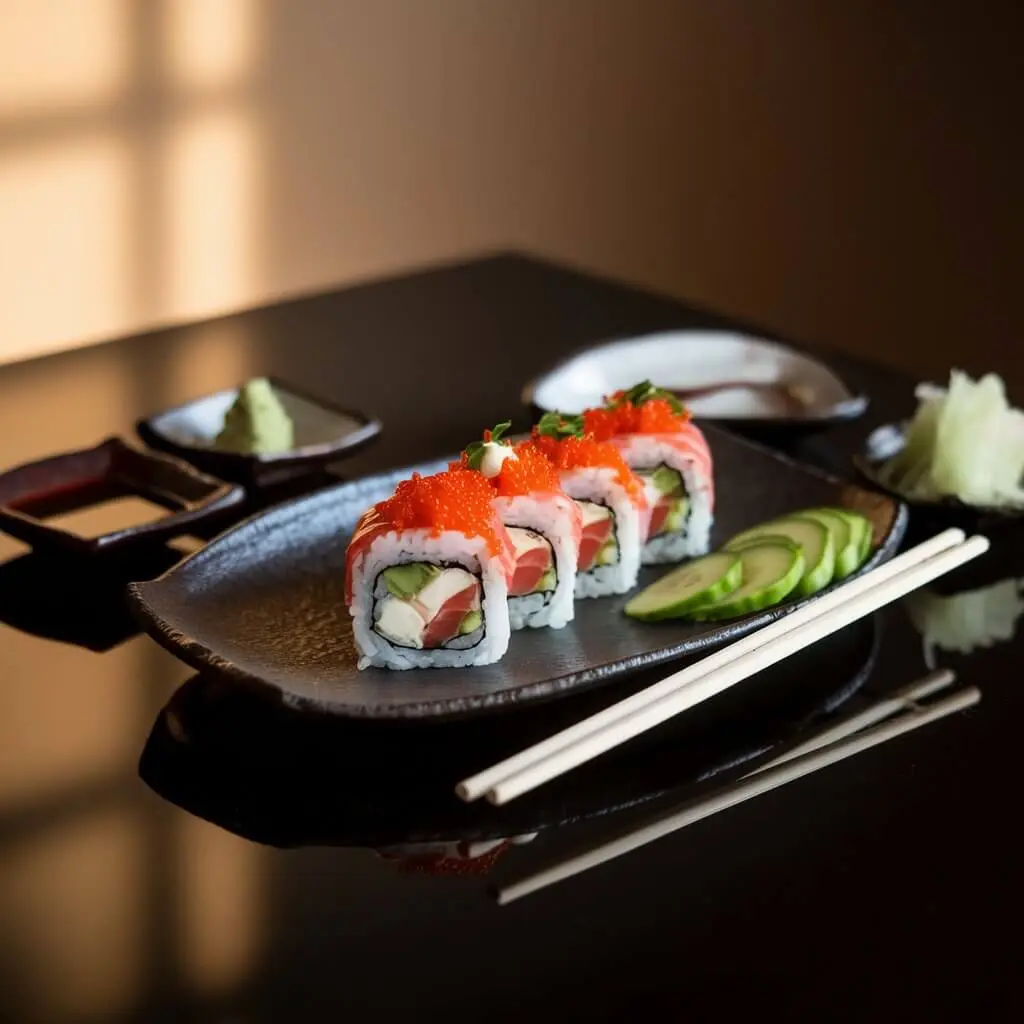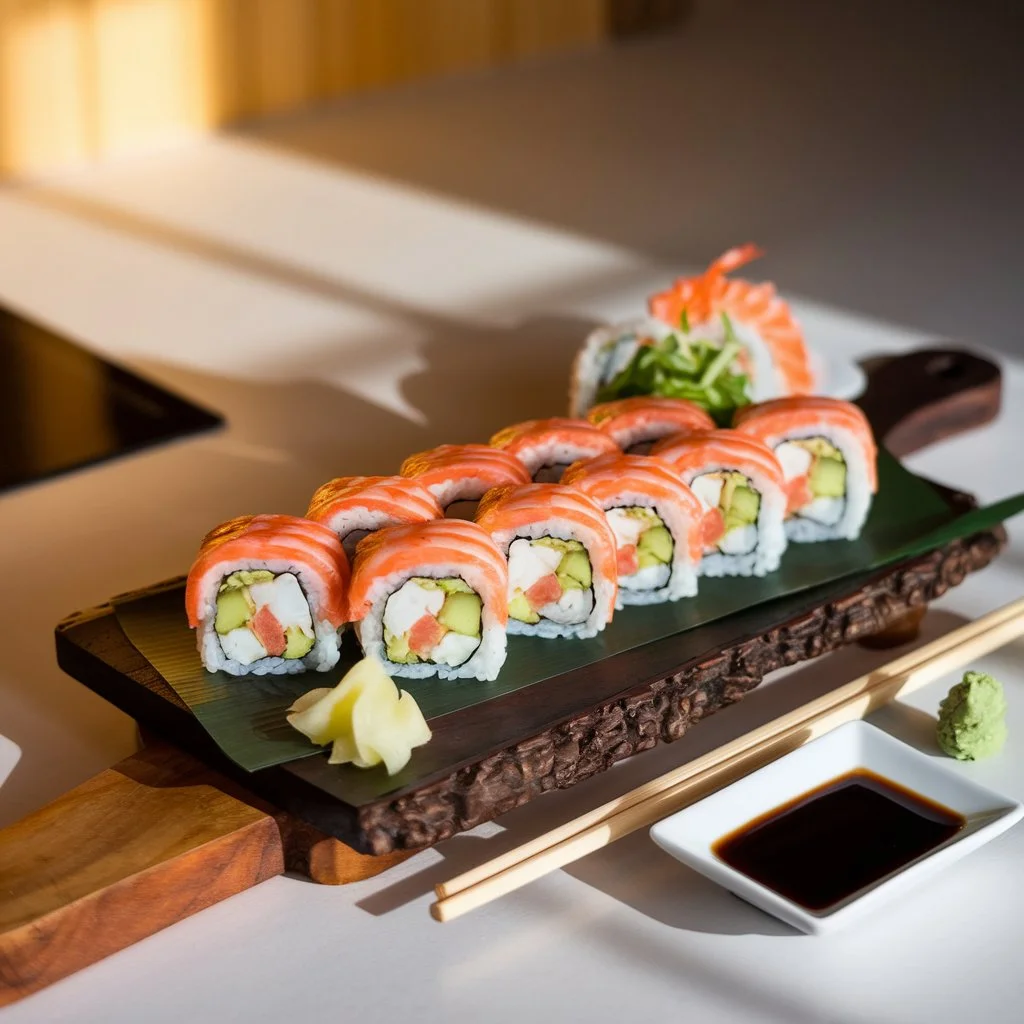If you love sushi but aren’t quite ready to dive into raw fish, the Boston Roll is the perfect choice for you. This delicious and beginner-friendly sushi roll offers the fresh, vibrant flavors of traditional sushi while using cooked shrimp instead of raw seafood, making it a great option for those new to sushi or who prefer a milder taste.
Originating as a regional adaptation of the classic sushi roll, the Boston Roll features shrimp, creamy avocado, and crisp cucumber, all wrapped in a delicate sheet of nori (seaweed) and sushi rice. The roll is often topped with tobiko (fish roe) for a pop of color and subtle crunch, elevating both its texture and presentation.
While sushi may seem intimidating to make at home, with the right ingredients and simple techniques, you can recreate this restaurant-quality roll in your own kitchen. This guide will walk you through everything you need to know—from selecting the freshest ingredients and preparing sushi rice to rolling and slicing the perfect Boston Roll.
Whether you’re hosting a sushi night with friends, looking for a fun DIY dinner idea, or just craving a light and flavorful meal, this easy homemade Boston Roll recipe will quickly become one of your favorites. Let’s get started!
Table of Contents
What Is a Boston Roll? A Quick Introduction
The Boston Roll is a popular sushi roll that puts a unique twist on traditional sushi by using cooked shrimp instead of raw fish. This makes it an excellent choice for those who enjoy sushi flavors but may be hesitant to eat raw seafood. With its fresh, crisp ingredients and light, delicate taste, the Boston Roll has gained popularity both in Japanese restaurants and among home cooks looking to try their hand at sushi-making.
What Makes the Boston Roll Unique?
Sushi rolls come in many varieties, but the Boston Roll stands out due to its ingredients and preparation method. While traditional sushi often incorporates raw fish such as tuna or salmon, the Boston Roll features cooked shrimp as its star ingredient. This small but important difference makes it more accessible for people who prefer their seafood fully cooked.
Another key characteristic of the Boston Roll is its inside-out rolling style (known as uramaki), where the sushi rice is on the outside, and the nori (seaweed) wraps around the filling. This technique is similar to the California Roll, but instead of imitation crab, the Boston Roll uses shrimp. It also shares similarities with shrimp tempura rolls, but the shrimp in a Boston Roll is typically boiled or steamed rather than fried.
Here’s how the Boston Roll compares to other popular sushi rolls:
- Boston Roll vs. California Roll – Both are inside-out rolls, but the Boston Roll contains shrimp, while the California Roll features imitation crab.
- Boston Roll vs. Spicy Tuna Roll – The Boston Roll is milder in flavor and uses cooked shrimp, whereas the Spicy Tuna Roll includes raw tuna mixed with spicy mayo.
- Boston Roll vs. Philadelphia Roll – While the Boston Roll relies on shrimp, avocado, and cucumber, the Philadelphia Roll contains smoked salmon and cream cheese.
The Key Ingredients in a Boston Roll
A Boston Roll uses a combination of fresh, simple ingredients that come together to create its signature flavor and texture. Each component plays an important role in the overall balance of the sushi roll:
- Shrimp – Cooked shrimp (often boiled or steamed) replaces raw seafood, making this roll more approachable for those new to sushi.
- Avocado – Creamy avocado adds richness and a smooth texture that complements the shrimp.
- Cucumber – Thinly sliced cucumber provides a refreshing crunch.
- Sushi Rice – Short-grain rice seasoned with rice vinegar, sugar, and salt gives the roll its signature stickiness and flavor.
- Nori (Seaweed) – A sheet of dried seaweed holds the ingredients together and enhances the umami flavor.
- Tobiko (Fish Roe) – While optional, tobiko (tiny fish eggs) are often sprinkled on top for an extra burst of texture and a pop of color.
Is the Boston Roll Cooked or Raw?
One of the main appeals of the Boston Roll is that it is entirely cooked, making it a great option for sushi beginners or those who prefer not to eat raw fish. Since the shrimp in this roll is boiled or steamed before being used, it provides a mild, slightly sweet seafood flavor without the concerns that some people have with raw sushi.
The fully cooked nature of the Boston Roll also makes it an excellent choice for families, children, and pregnant women who may need to avoid raw fish but still want to enjoy sushi flavors. Plus, since it’s relatively easy to prepare, it’s one of the best sushi rolls to make at home with minimal effort.
Now that you know what makes the Boston Roll special, let’s dive into the ingredients and tools you’ll need to make it yourself!
Essential Ingredients and Tools for Making a Boston Roll

Before you start rolling sushi, it’s important to gather the right ingredients and tools. Making sushi at home is much easier when you have high-quality ingredients and the proper equipment. In this section, we’ll cover the essential components of a Boston Roll, the tools that make the rolling process smooth, and the best places to find fresh sushi ingredients.
Ingredients You’ll Need
A Boston Roll is known for its simple yet flavorful combination of ingredients. Each element contributes to the roll’s taste, texture, and presentation, so choosing fresh, high-quality ingredients is key to making your sushi delicious.
1. Shrimp (Cooked Shrimp)
- The main protein in a Boston Roll is cooked shrimp.
- Typically, shrimp is boiled or steamed before use, ensuring a mild, slightly sweet flavor that pairs well with the other ingredients.
- Choose medium or large shrimp, as they provide the best texture and are easier to work with.
2. Sushi Rice (Short-Grain Rice)
- Sushi rice is short-grain Japanese rice, known for its sticky texture that helps hold the roll together.
- The rice is seasoned with a blend of rice vinegar, sugar, and salt to enhance its flavor.
- To get the right consistency, rinse the rice thoroughly before cooking and use a rice cooker or stovetop method for perfect results.
3. Nori (Seaweed Sheets)
- Nori is the dried seaweed used to wrap sushi rolls.
- It provides a slight umami flavor and structural support for the roll.
- Choose high-quality nori with a dark green, almost black color, as this indicates freshness.
4. Avocado
- Avocado adds a creamy, buttery texture that complements the shrimp.
- Choose a ripe avocado that is firm yet slightly soft to the touch, making it easy to slice.
- Thinly slice the avocado so it rolls smoothly with the other ingredients.
5. Cucumber
- Cucumber provides a refreshing crunch that balances the softness of the avocado and shrimp.
- English cucumbers are ideal because they have fewer seeds and thinner skin.
- Slice the cucumber into thin, matchstick-sized pieces for easy rolling.
6. Soy Sauce
- Used as a dipping sauce, soy sauce enhances the overall umami taste of the Boston Roll.
- Choose low-sodium soy sauce if you prefer a milder saltiness.
7. Wasabi (Optional)
- A small amount of wasabi (Japanese horseradish) can be added for a spicy kick.
- If you like spicy sushi, you can mix wasabi into the soy sauce or add a small dab inside the roll.
8. Tobiko (Optional Topping)
- Tobiko (fish roe) is often sprinkled on top of Boston Rolls for a crunchy texture and bright orange color.
- It adds a mildly salty and slightly smoky taste to the sushi.
- If tobiko isn’t available, masago (capelin roe) is a good alternative.
Kitchen Tools Required
Sushi-making requires a few specialized tools that make the process easier and more efficient. Here are the essential tools you’ll need to make a perfect Boston Roll at home:
1. Bamboo Sushi Rolling Mat (Makisu)
- A bamboo mat helps shape the sushi roll evenly.
- It provides firm but flexible support when rolling the ingredients together.
- For best results, wrap the mat in plastic wrap before use to prevent rice from sticking.
2. Sharp Knife (For Cutting Sushi Rolls)
- A very sharp knife is essential for cutting clean, even slices of sushi.
- Dull knives can crush the roll instead of slicing through it.
- For best results, wet the knife blade with water before cutting to prevent the rice from sticking.
3. Rice Paddle (Shamoji)
- A flat rice paddle is used to mix and spread sushi rice evenly.
- Using a rice paddle instead of a spoon helps prevent the rice from getting too compact or sticky.
4. Cutting Board
- A large cutting board provides a stable surface for slicing ingredients and assembling the sushi roll.
5. Small Bowl of Water with Rice Vinegar
- This is used to wet your hands before handling sushi rice, preventing it from sticking to your fingers.
Where to Buy Fresh Sushi Ingredients
Finding high-quality sushi ingredients is key to making delicious homemade sushi. Here are the best places to source fresh ingredients:
1. Local Asian Grocery Stores
- Japanese or Asian supermarkets typically carry fresh sushi-grade shrimp, sushi rice, nori, and other essentials.
- Stores like H Mart, Mitsuwa, or 99 Ranch Market are great options if you have one nearby.
2. Online Specialty Stores
- Many online retailers sell sushi-making kits, nori, tobiko, and sushi rice.
- Popular websites for sushi ingredients include:
- Amazon (for non-perishable items like nori and sushi mats)
- Umami Insider (for authentic Japanese ingredients)
- Marukai Market Online (for premium sushi-grade seafood)
3. Regular Supermarkets
- Many large grocery stores have an international aisle with nori, sushi rice, and soy sauce.
- Fresh shrimp and avocado are usually available in the seafood and produce sections.
4. Seafood Markets
- If you want high-quality shrimp, check your local seafood market for fresh or frozen options.
- Some seafood markets also carry tobiko and other sushi-related ingredients.
Step-by-Step Guide to Making a Boston Roll

Now that you have gathered all the necessary ingredients and tools, it’s time to put them to use! Making a Boston Roll at home requires three key steps: preparing sushi rice, assembling and rolling the sushi, and slicing it properly for the perfect presentation. Follow this step-by-step guide to achieve a restaurant-quality Boston Roll right in your kitchen.
Step 1: Preparing the Sushi Rice Perfectly
Sushi rice is the foundation of any sushi roll, and getting the right texture is crucial. It should be slightly sticky yet fluffy, so it holds the roll together without being too dense.
Ingredients for Sushi Rice:
- 1 ½ cups Japanese short-grain sushi rice
- 2 cups water
- 3 tbsp rice vinegar
- 1 tbsp sugar
- ½ tsp salt
Instructions:
- Rinse the Rice
- Place the sushi rice in a bowl and rinse it under cold water.
- Stir the rice with your fingers and drain the cloudy water.
- Repeat this process 3-4 times until the water runs clear.
- This step removes excess starch, preventing the rice from becoming overly sticky.
- Cook the Rice
- Transfer the rinsed rice to a rice cooker or a saucepan.
- Add 2 cups of water and let it sit for 10 minutes before cooking.
- If using a rice cooker, press the “cook” button and let it steam once done.
- If cooking on the stovetop, bring the water to a boil, reduce the heat to low, and cover the pot. Let it simmer for 12-15 minutes, then turn off the heat and let it sit covered for another 10 minutes.
- Season the Rice
- In a small saucepan, combine rice vinegar, sugar, and salt over low heat. Stir until dissolved.
- Pour the mixture over the cooked rice and gently fold it in using a rice paddle or wooden spoon.
- Be careful not to mash the rice—use a slicing motion to mix it evenly.
- Cool the Rice
- Spread the rice onto a large tray or wooden bowl to cool slightly.
- Cover it with a damp kitchen towel to keep it from drying out while preparing the other ingredients.
Step 2: Assembling the Boston Roll – Rolling Techniques
Now that your sushi rice is ready, it’s time to assemble and roll the Boston Roll.
Ingredients for Assembly:
- 1 sheet of nori (seaweed)
- ½ cup prepared sushi rice
- 3 cooked shrimp (butterflied or chopped into small pieces)
- ¼ avocado (thinly sliced)
- ¼ cucumber (cut into thin strips)
- Tobiko (optional, for topping)
Instructions:
1. Prepare Your Work Surface
- Lay a bamboo sushi mat (makisu) on a clean, flat surface.
- Place a sheet of plastic wrap over the mat to prevent the rice from sticking.
2. Spread the Rice on the Nori
- Place one sheet of nori (shiny side down) onto the bamboo mat.
- Wet your fingers with a bowl of water mixed with a little rice vinegar to prevent sticking.
- Take about ½ cup of sushi rice and spread it evenly over the nori, leaving about ½ inch of space at the top edge to help seal the roll.
3. Flip the Nori Over
- Carefully flip the nori over, so the rice is now facing down on the plastic wrap.
- This technique is called uramaki (inside-out roll), where the rice is on the outside.
4. Arrange the Fillings
- Lay three pieces of cooked shrimp horizontally across the center.
- Add thin slices of avocado and cucumber strips on top of the shrimp.
- Make sure the ingredients are evenly distributed to ensure a balanced roll.
5. Roll the Sushi
- Lift the bottom edge of the bamboo mat using your thumbs, while holding the fillings in place with your fingers.
- Gently roll the sushi forward, applying light pressure to shape it into a cylinder.
- Use the mat to firmly press the roll to ensure it holds together.
- Continue rolling until the entire sheet is wrapped, then give it a final gentle squeeze to keep everything compact.
6. Add Toppings (Optional)
- If you want to add tobiko (fish roe), sprinkle it on top of the roll for a pop of color and crunch.
- Lightly press it into the rice so it adheres properly.
Step 3: Cutting and Presenting the Sushi Like a Pro
Slicing the roll cleanly is the final step to achieving a professional sushi presentation.
Tools Needed:
- A sharp knife (preferably a Japanese sushi knife or a very sharp chef’s knife)
- A damp kitchen towel
- A small bowl of water
Instructions:
1. Prepare the Knife
- Sushi rice is sticky, so a dry knife will not cut smoothly.
- Dip your knife in a bowl of water, then wipe it with a damp towel before slicing.
- Repeat this process after each cut to keep the slices clean.
2. Cut the Sushi Roll Evenly
- Place the roll on a clean cutting board.
- Slice the roll in half first, then cut each half into three even pieces, resulting in six sushi slices.
- Use a gentle sawing motion rather than pressing down too hard.
3. Arrange for Serving
- Arrange the sushi pieces neatly on a plate.
- Garnish with pickled ginger, wasabi, and soy sauce on the side.
Serving and Enjoying Your Homemade Boston Roll

Now that you’ve successfully prepared and rolled your Boston Roll, it’s time to serve it in a way that enhances its flavors and visual appeal. A well-presented sushi dish can elevate the dining experience, making it feel just like a meal from a high-end sushi restaurant. In this section, we’ll cover the best sauces and condiments to pair with your Boston Roll, presentation tips to impress your guests, and ideal beverage pairings to complement the flavors of your homemade sushi.
Best Sauces and Condiments to Pair With
While Boston Rolls are delicious on their own, sauces and condiments can enhance the taste by adding depth, spice, or a touch of sweetness. Here are some of the most popular accompaniments for Boston Rolls:
1. Soy Sauce (Shoyu) – The Classic Sushi Dip
- Why It Works: Soy sauce adds a rich umami flavor and enhances the taste of shrimp, avocado, and rice.
- How to Use:
- Pour a small amount into a shallow dipping dish.
- Dip just the edge of the sushi (not the rice) into the soy sauce to avoid making it too salty.
- If you prefer a milder taste, opt for low-sodium soy sauce.
2. Spicy Mayo – A Creamy, Spicy Kick
- Why It Works: The creamy texture and spicy heat contrast beautifully with the mild flavors of shrimp and avocado.
- How to Use:
- Mix 2 tbsp of mayonnaise with 1 tsp of Sriracha for an easy homemade spicy mayo.
- Drizzle it over the Boston Roll using a squeeze bottle or serve it on the side for dipping.
3. Wasabi – A Bold, Spicy Punch
- Why It Works: Wasabi adds an intense heat that enhances the seafood flavors.
- How to Use:
- Place a small pea-sized amount of wasabi on the sushi before eating.
- Mix a little wasabi into your soy sauce for an extra kick.
- Be cautious—a little goes a long way!
4. Pickled Ginger (Gari) – A Refreshing Palate Cleanser
- Why It Works: The mild sweetness and tangy flavor of pickled ginger cleanse your palate between bites.
- How to Use:
- Serve a few slices on the side of your sushi platter.
- Eat a small piece between different sushi rolls to fully enjoy each flavor.
5. Eel Sauce (Optional) – A Sweet and Savory Glaze
- Why It Works: Eel sauce adds a deep umami richness that complements the shrimp and avocado.
- How to Use:
- Drizzle lightly over the Boston Roll for an extra layer of flavor.
- To make homemade eel sauce, simmer ¼ cup soy sauce, 2 tbsp mirin, and 1 tbsp sugar until slightly thickened.
Presentation Tips for an Elegant Sushi Platter
Beautifully arranged sushi is just as important as its taste. Here’s how to plate and present your Boston Roll like a pro:
1. Use a Sushi Plate or Wooden Board
- Why It Works: A traditional long sushi plate or bamboo sushi board provides an elegant presentation.
- Pro Tip: Arrange your sushi pieces in a neat row or circular pattern for a visually appealing layout.
2. Add Colorful Garnishes
- Sprinkle tobiko (fish roe) on top for a pop of bright orange.
- Chop green onions or sesame seeds and lightly dust the top for extra contrast.
- Arrange thin slices of avocado in a fan shape next to the sushi for added aesthetics.
3. Serve with Artful Sauce Drizzles
- Use a squeeze bottle to drizzle spicy mayo or eel sauce in a zig-zag pattern across the plate.
- For an elegant touch, create small sauce dots on the plate using the back of a spoon.
4. Organize Condiments Neatly
- Place a small dish of soy sauce next to the sushi.
- Arrange pickled ginger and wasabi in separate sections of the plate to keep flavors distinct.
5. Use Chopsticks and Traditional Dishware
- Serve your Boston Roll with chopsticks for authenticity.
- If available, use Japanese ceramic sushi plates or bamboo serving boards for a restaurant-style feel.
Beverages That Complement a Boston Roll
Pairing the right drink with your sushi can enhance its flavor profile. Here are some ideal beverage choices to complement your Boston Roll:
1. Green Tea (Hot or Iced) – A Traditional Japanese Pairing
- Why It Works: Green tea’s mild bitterness balances the sweetness of the sushi rice and enhances umami flavors.
- Best Types:
- Sencha (light and refreshing)
- Genmaicha (toasty and nutty, with roasted rice flavors)
- Matcha (rich and earthy, perfect for special occasions)
2. Sake – A Classic Sushi Companion
- Why It Works: Sake’s delicate sweetness complements the mild shrimp flavor in a Boston Roll.
- Best Types:
- Junmai Daiginjo (light and floral, ideal for sushi)
- Nigori Sake (cloudy, slightly sweet, pairs well with spicy mayo)
3. Light Japanese Beer – Crisp and Refreshing
- Why It Works: A cold, crisp beer contrasts well with the creamy avocado and shrimp.
- Best Choices:
- Asahi Super Dry (clean, refreshing, pairs well with sushi)
- Sapporo (light and slightly malty, enhances umami flavors)
4. White Wine – A Smooth and Balanced Option
- Why It Works: White wine’s acidity cuts through the richness of avocado and balances the soy sauce.
- Best Varietals:
- Sauvignon Blanc (zesty citrus notes, complements shrimp and cucumber)
- Riesling (lightly sweet, pairs well with spicy mayo)
5. Sparkling Water or Lemon-Infused Water – A Non-Alcoholic Alternative
- Why It Works: Refreshing and palate-cleansing, sparkling water keeps your taste buds fresh between bites.
- Best Pairings:
- Sparkling water with a twist of lemon or lime
- Cucumber-infused water for a refreshing touch
Common Mistakes to Avoid When Making a Boston Roll
Making sushi at home can be a fun and rewarding experience, but small mistakes can lead to rolls that are too loose, too sticky, or difficult to cut. Understanding these common errors will help you create a Boston Roll that is well-balanced, visually appealing, and holds together properly. Below are some of the most frequent challenges beginners face and how to avoid them.
Why Sushi Rice Texture Matters (Avoiding Overly Sticky or Dry Rice)
Sushi rice is the foundation of any sushi roll, and getting the texture right is crucial. If the rice is too sticky, it can be difficult to work with, causing it to clump together and make rolling harder. On the other hand, if the rice is too dry, it won’t hold the roll together properly, making it more likely to fall apart when sliced.
One of the biggest mistakes is skipping the rinsing step. Unrinsed rice contains excess starch, which can lead to a mushy texture instead of the light and slightly sticky consistency needed for sushi. Another common issue is using too much or too little water when cooking the rice, which affects the final texture. Proper seasoning is also important—adding the correct balance of rice vinegar, sugar, and salt gives the rice its distinct sushi flavor and helps it bind together effectively.
To ensure perfect sushi rice, rinse it thoroughly under cold water until the water runs clear, removing excess starch. Use the correct water-to-rice ratio when cooking to prevent undercooked or overly wet rice. Once cooked, allow the rice to steam for about ten minutes before seasoning it with a mixture of rice vinegar, sugar, and salt. When mixing, avoid smashing the grains and use a gentle folding motion to distribute the seasoning evenly.
How to Prevent Sushi Rolls from Falling Apart (Proper Rolling and Rice-to-Filling Ratio)
One of the most frustrating issues when making sushi at home is rolls that fall apart. This can happen for several reasons, including an improper rolling technique, using too much or too little rice, or overstuffing the roll with ingredients.
A common mistake is spreading the rice too thickly on the nori. While sushi rice is essential for binding the roll, using too much makes it difficult to roll tightly. Alternatively, using too little rice won’t provide enough structure, causing the roll to fall apart when picked up or dipped into soy sauce.
Another issue is overfilling the roll. While it’s tempting to add more shrimp, avocado, and cucumber for extra flavor, too many ingredients make it difficult to seal the roll properly. This leads to loose sushi rolls that unravel when sliced.
Rolling technique also plays a key role. If not enough pressure is applied while rolling, the ingredients won’t hold together, resulting in a roll that loses its shape. The right balance is needed—press firmly but gently when rolling to create a compact and well-structured sushi roll.
To fix these issues, spread a thin, even layer of sushi rice on the nori, leaving a half-inch border at the top to help seal the roll. Limit the fillings to just three main ingredients to prevent overstuffing. When rolling, use both hands to guide the bamboo sushi mat and apply gentle but firm pressure, making sure the ingredients are tightly packed without squeezing them too hard.
Cutting Sushi Rolls the Right Way (Using a Sharp, Wet Knife for Clean Slices)
Cutting sushi rolls properly is just as important as rolling them correctly. A dull knife can crush the roll instead of slicing through cleanly, making the pieces look uneven and messy. If the blade isn’t wet, the sticky sushi rice may cling to it, tearing the roll apart as you cut.
Many beginners try to slice sushi rolls using a standard kitchen knife without sharpening it first. A blunt blade won’t glide smoothly through the roll, causing the fillings to shift and the nori to tear. Another common mistake is pressing down too hard while cutting, which compresses the sushi roll instead of slicing it cleanly.
To ensure neat, even slices, always use a sharp sushi knife or a very sharp chef’s knife. Wet the blade with water before cutting to prevent the rice from sticking. Instead of pressing down forcefully, use a gentle sawing motion to slice through the roll. It’s best to cut the roll in half first, then cut each half into three equal pieces for a total of six uniform sushi slices.
Placing the sushi roll in the refrigerator for a few minutes before cutting can also help firm it up slightly, making it easier to slice cleanly. By using the right knife and technique, you’ll achieve beautifully cut Boston Roll pieces that look as good as they taste.
By avoiding these common mistakes, your homemade Boston Roll will turn out just as delicious and visually appealing as the ones served in sushi restaurants. Whether it’s getting the rice texture just right, mastering the rolling technique, or perfecting your slicing skills, small improvements in each step will lead to a sushi roll that is easy to handle, holds together well, and delivers the perfect balance of flavors in every bite.
Final Thoughts
Making a Boston Roll at home may seem intimidating at first, but with the right ingredients, tools, and techniques, it becomes an enjoyable and rewarding experience. Unlike traditional sushi rolls that use raw fish, the Boston Roll is an excellent option for those who prefer cooked seafood while still enjoying the flavors and textures of sushi. The combination of tender shrimp, creamy avocado, crisp cucumber, and perfectly seasoned sushi rice creates a well-balanced and refreshing bite that sushi lovers can’t resist.
One of the greatest advantages of making sushi at home is the ability to customize it to your liking. Whether you want to experiment with different fillings, adjust the level of seasoning in the rice, or add unique toppings like spicy mayo or tobiko, homemade sushi allows for endless creativity. You can even try serving it alongside other sushi varieties, such as California Rolls or Spicy Tuna Rolls, to create a full sushi platter for a restaurant-style dining experience at home.
If you’re new to sushi-making, don’t be discouraged if your first roll isn’t perfect. Like any cooking skill, practice makes perfect. The key is to focus on achieving the right rice consistency, mastering the rolling technique, and using a sharp knife for clean slices. With each attempt, your rolls will become neater, more structured, and more flavorful.
A Boston Roll is perfect for any occasion—whether you’re preparing a light lunch, an impressive dinner, or a fun sushi night with friends and family. It’s a great way to introduce sushi to beginners while still offering a satisfying and delicious dish for seasoned sushi fans. Plus, the use of cooked shrimp makes it a safer and more approachable option for those who are hesitant about raw seafood.
Now that you’ve learned everything from choosing the right ingredients to rolling and serving your sushi like a pro, it’s time to put your skills to the test. Gather your ingredients, follow the step-by-step guide, and enjoy the fresh, homemade taste of Boston Rolls in the comfort of your own kitchen. Once you’ve mastered this roll, you might even be inspired to try other sushi variations and elevate your sushi-making expertise even further.
So why not give it a try today? Your homemade Boston Roll is sure to impress, and the experience of making it yourself is just as enjoyable as eating it.
To discover more about my cooking journey and get to know me better, head over to my About Me page for all the details!

